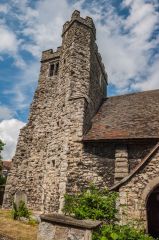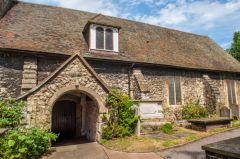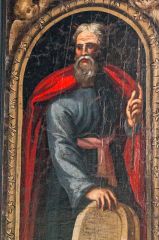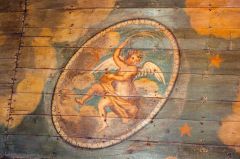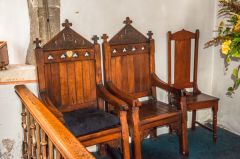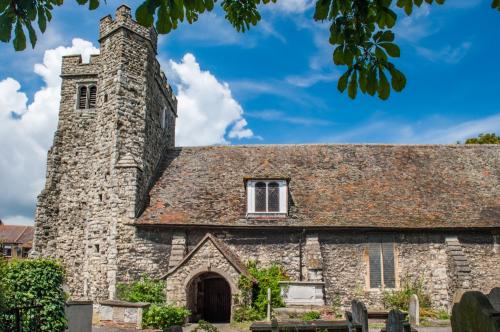
Queenborough's delightful parish church was built by Edward III, though the date of construction is unclear. Some sources suggest that the church was begun around 1350, but others point to a date of 1366. Yet another theory is that the king adapted a tower from a much earlier church on this site.
All sources agree that the church was complete by 1367. Holy Trinity is one of just three churches comprising West Sheppey Parish, with Minster Abbey and Holy Trinity at Sheerness being the others.

History
Queenborough was a planned town, built around Queenborough Castle, which was begun in 1361 to defend the entrance to the Medway. The town was named for Queen Philippa, Edward's consort. The castle was finished in 1367 and was the first concentric castle built in England.
Holy Trinity did not have its own parish; it was built as a chapel to the abbey at Minster in Sheppey, a few miles away. For over three centuries, the church was served by a priest from the abbey.
This changed in 1667 when Queenborough was detached from the abbey and became a parish in its own right. Priests were appointed by the Mayor and council of Queenborough until 1884 when the patronage passed to the Archbishop of Canterbury.

The church has connections with several famous people. The artist William Hogarth visited here, and Lord Nelson attended service whilst residing in Queenborough.
The church plate includes a silver Communion set given by Charles II's Secretary of State, Sir Joseph Williamson. The Communion set is on display at Leeds Castle, near Maidstone.
The oldest part of the present building is the tower, which dates to the late Norman period. The arch that connects the tower to the nave is much later, and in Gothic style. The original floor was much lower. This can be seen in the level of the piscina in the south wall of the chancel and in the position of the east window.

Charity Boards
Look for painted boards displaying the Queenborough Charities; gifts given to support the poor and needy of the parish. One of the most intriguing gifts was made by two unnamed men who were shipwrecked off Queenborough and gave forty pounds to the Queenborough Corporation 'the interest to be applied for an annual sermon and for behoof [sic] of the poor.'
Another benefaction board recalls the restoration of the church by Thomas King, Esq., who gave money so that the church 'was raised, paved, pewed and ceiled, and the gallery erected with the altar and painting to it.'
The wrought-iron altar rail is all that remains of a much larger screen that separated the chancel from the nave. The screen stood fully 8 feet high and was erected in the reign of Queen Anne to take the place of the original screen built by Edward I and destroyed by Cromwell's men during the English Civil War.
The pews are Victorian, as is the stained glass in the east window, inserted in honour of Richard Comyn (d. 1874), who served as Mayor of Queenborough three times. Comyn's grave is in the churchyard.

The Whale Tablet
On the north wall is 'the Whale Tablet', brought inside the church from its original home in the churchyard. The tablet commemorates Henry Knight, a former mayor and a seafarer whose voyages took him as far afield as Greenland. Knight is thought to have been one of the first Europeans to explore the Arctic.
The tablet features a very rough drawing of a harpoon below an inscription that reads, in part, 'In Greenland I whales, sea horse, bears did slay, Though now my body is entombed in clay.'
The font dates to 1610 and still has its Jacobean cover. The cover is inscribed with the name of Nicholas Taylor, a Jurat of Queenborough, who gave the cover. Carved into the font is a depiction of the postern gate of Queenborough Castle, destroyed in 1650 by Cromwell.

Yet another castle connection is provided by the sanctuary chairs, which were made from timber rescued from the castle.
There are two brass candelabra. These were a gift to the church of George Isles, who served as Mayor of Queenborough a remarkable 14 times.
On the south wall hangs a royal coat of arms, painted in 1713. Note that the head of the royal lion on the coat of arms bears the face of Charles I. This is a nod of gratitude towards the king who granted Queenborough its royal charter.
Below the coat of arms are the Corporation seats, used by the mayor and councillors of Queenborough on civic occasions.
Another historical feature is a pair of wonderful framed paintings depicting Moses and Aaron.
The Painted Ceiling
Now we come to the real centrepiece of Holy Trinity Church; the painted ceiling. This was the work of an unknown Dutch artist around 1698. The ceiling depicts the firmament with four cherubs in painted medallions in the corners, while the centrepiece shows the Angel of the Apocalypse sounding a trumpet. The ceiling was damaged by fire in 1933 but remains an extraordinary piece of 17th-century art.
One final highlight is the striking tomb of Thomas Greet, in the churchyard. This tomb, with its peculiar obelisk centrepiece, remembers a wealthy local figure whose portrait hangs in the Guildhall.

Visiting
Holy Trinity Church is located on the High Street, just off the B2007, but you can also access the church through the graveyard, with an entrance on North Street. It was open when we visited and, as far as we can determine, is typically open to visitors.
There is limited on-street parking on High Street and North Street. We would suggest North Street, which has slightly easier parking. If you don't mind a stroll, there is a car park off Well Road, a few minutes away on foot.
About Queenborough, Holy Trinity Church
Address: High Street,
Queenborough,
Kent,
England, ME11 5AG
Attraction Type: Historic Church
Location: Access from High Street or North Street (B2007), with on-street parking along both roads. There is also a car park off Well Street.
Website: Queenborough, Holy Trinity Church
Location
map
OS: TQ909723
Photo Credit: David Ross and Britain Express
HERITAGE
 We've 'tagged' this attraction information to help you find related historic attractions and learn more about major time periods mentioned.
We've 'tagged' this attraction information to help you find related historic attractions and learn more about major time periods mentioned.
Find other attractions tagged with:
NEARBY HISTORIC ATTRACTIONS
Heritage Rated from 1- 5 (low to exceptional) on historic interest
Luddenham, St Mary's Church - 7.7 miles (Historic Church) ![]()
Kingsdown, St Catherine's Church - 8.5 miles (Historic Church) ![]()
Faversham Stone Chapel - 8.6 miles (Historic Building) ![]()
Bredgar & Wormshill Light Railway - 8.7 miles (Family Attraction) ![]()
Royal Engineers Museum - 9.3 miles (Museum) ![]()
Upnor Castle - 9.4 miles (Castle) ![]()
Doddington Place Gardens - 9.4 miles (Garden) ![]()
Historic Dockyard Chatham - 9.5 miles (Museum) ![]()
Nearest Holiday Cottages to Queenborough, Holy Trinity Church:
More self catering near Queenborough, Holy Trinity Church

